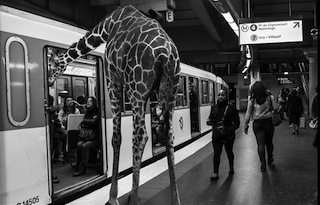 What is it to be human? Traditionally, human nature is set in opposition to the nature of animals. Yet, at least since evolutionary theory, humans are understood as part of the animal kingdom. Philosophical discourse is investigating a number of questions regarding the nature of animals and our relationship with them. The dichotomies of rationality and instinct or civility and wildness are at the heart of such deliberations. Ethical debates around the treatment and our relationship with animals are at the forefront. How are these debates informed by the traditions of representations of animals?
What is it to be human? Traditionally, human nature is set in opposition to the nature of animals. Yet, at least since evolutionary theory, humans are understood as part of the animal kingdom. Philosophical discourse is investigating a number of questions regarding the nature of animals and our relationship with them. The dichotomies of rationality and instinct or civility and wildness are at the heart of such deliberations. Ethical debates around the treatment and our relationship with animals are at the forefront. How are these debates informed by the traditions of representations of animals?
Our relationship to animals is ambivalent and based on irrational distinctions. In our society certain animals are considered ‘food’, others are loved as pets whilst their kin are used in medical testing. Historically, western society relies on domesticated animals and their products (beyond food), but urban and agricultural developments threaten habitats and thereby animal (as well as plant) species. We recognise endangered species, but only engage with the protection of fluffy mammals as opposed to less appealing reptiles and insects.
We cannot live without animals.
Animals are the stuff of nightmares (e.g. man-eating sharks) and dreams (e.g. swimming with dolphins). Real and mythical animals populate western imagination. Our language is saturated with similes (brave as a lion, strong as an ox) and metaphors (sheepish, doe-eyed). Expressions and idioms reach from biblical stories (the snake in garden Eden) to cinematic references (Dumbo’s ears).
Visually, the importance of our relationship to animals is reflected in a rich history of animal imagery, from cave paintings to contemporary art. The presence (or absence) of images of animals in certain contexts is expressing how we consider and evaluate animals. Photographically, images range from facebook cat portraits (apparently more common than selfies, Telegraph, February 2014) to thoughtful deliberations such as Alessandra Sanguinetti’s book On the Sixth Day, which unfolds “a tale of animals and humans, of their interaction and dependence” (Robert Blake’s essay in Sanguietti, 2006).
More broadly, animal studies encompass a multitude of investigations regarding our relationship to animals and the status and meaning of animals within our society and exploring ethical, environmental, artistic and many other areas. The presence and its form or, indeed, absence of animal images in photographic imagery portrays crucial aspects about humanity today.
This conference aims to provide a platform for a debate questioning the meaning animals for contemporary society as seen through photography.
Suggested photographic themes:
Animal metaphors
- Animal myths and stories
- Animality & humanity
- Anthropomorphism
- Seeing the animal as animal
- Visualising the nature/essence of certain animals
- Animal symbols
- Cultural significance
Living with animals – animals living with us
- Pets
- Working animals
- Domestic animals
- Support animals
- Animals and ecology
- Animal danger
Animal exploitation / economy of animals
- Working animals again?
- Food production
- Animal products in general
- Medical experiments, cosmetics industry etc.
- Animals in fashion
Animals and violence
- Neglect
- Animal attacks
- Fear of animals, phobias
- Trophies
History of animal perception
- Impact of history of art on animal photography
- History of wildlife imagery
- Changes in respect / admiration for or disgust / repellence by certain animals
- Changes in ethical considerations regarding animals
SUBMISSION DETAILS
Paper proposals are invited for 20min presentations. Please submit a 300w abstract, up to 3 low-resolution images and a 150w biographical note to visualising@cumbria.ac.uk by 15th March
The peer-reviewed selection will be concluded and authors notified by the 15th April.
For further information see http://www.visualisingconference.com/
Or contact
Katrin Joost (katrin.joost@cumbria.ac.uk) or Sarah Bonner (sarah.bonner@cumbria.ac.uk)
Visualising the Animal
A conference bringing together theorists and practitioners in the field of photography rethinking visualisations of animals
18th – 19th June 2015 – University of Cumbria
Confirmed speakers:
Steve Baker, Emeritus Professor in Art History, University of Central Lancashire
John Darwell, Independent Photographer and Reader in Photography, University of Cumbria

Leave a Reply
You must be logged in to post a comment.